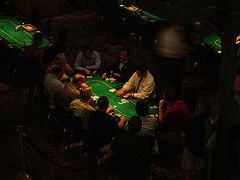Basic Sit And Go Poker Strategy
 Sit and Go tournaments are single table freeze out tournaments that award cash prizes to the top two or three finishers. Sit and gos are a very different form of poker than any other. While the rules of the game remain the same, poker sit and go strategy is very different, and I think it could be considered a completely different form of poker altogether. There is very little postflop play when you attack sit and go tournament strategy correctly. You will annoy the hell out of your opponents by pushing all in a lot and almost never calling anything. It is very fun to piss off your opponents regularly and then take all of their chips. Come on and admit it, you know it is.
Sit and Go tournaments are single table freeze out tournaments that award cash prizes to the top two or three finishers. Sit and gos are a very different form of poker than any other. While the rules of the game remain the same, poker sit and go strategy is very different, and I think it could be considered a completely different form of poker altogether. There is very little postflop play when you attack sit and go tournament strategy correctly. You will annoy the hell out of your opponents by pushing all in a lot and almost never calling anything. It is very fun to piss off your opponents regularly and then take all of their chips. Come on and admit it, you know it is.
A common prize structure for a nine and ten man sit and go is:
- 1st place 50% of the prize pool
- 2nd place 30% of the prize pool
- 3rd place 20% of the prize pool
And six man sit and gos:
- 1st place 65% of the prize pool
- 2nd place 35% of the prize pool
The most important thing to remember in order make a profit in sit and gos is to aim for first. You won’t make any money at sit and gos by trying to scrape by and limp in to third place for a payout. The money comes from first and second place finishes.
This strategy article will be broken up into three sections: early, middle, and late stage play of a sit and go.
The Early Stage
For our purposes, we’ll consider the early stage of a Texas holdem sit and go tournament to be the first three blind levels. During this time, the blinds are small relative to the stacks and most of the players are still in.
This is not the time to loosen up, play a lot of hands and try to hit some flops. The same strategy applies in sit and gos as in cash games: be tight in choosing your starting hands and be aggressive with the hands you do play. This is probably the single most common mistake in sit and gos.
Play exceptionally tight from early and middle position. Don’t limp in from early and middle position with small pairs hoping to hit sets. You and/or your opponents won’t have stacks large enough to make it worthwhile to call raises at this point in the tournament, or at any other time for that matter. You simply don’t start with enough chips to call raises to try and see flops. If you are routinely calling off 100 of your starting 1500 chips to see if you’ll flop a set with pocket fives, you will be losing your entire buy-in much too regularly.
As you get in to late position, you can open up your game a little and try to make something happen. In late position, you can get away with limping in with medium sized pocket pairs and raising with hands like KQo, depending on how many people have entered the pot.
In the early stage of a sit and go, I recommend sticking to big hands like AA, KK, QQ, JJ and AK from early position and adding hands like 77-TT, AQ, AJ and KQ in late position.
The Middle Stage
In the middle stage a few players have gone out and the tournament is in the fourth or fifth level of blinds. The blinds are becoming large enough for you to start stealing them. You’ll want to pick your spots carefully, though. Depending on your stack size, any postflop confrontation is likely to be an all-in or fold situation.
You will still want to pay close attention to your position in the middle stages, but you can now open up your game a little. Depending on how many people are still in the tournament, you can start raising from all positions the hands you only played in late position during the early stage.
The Late Stage
If you’ve made it this far, you’ve done well but your job is far from over. Don’t go thinking you can just coast into the money, take a second or third place and call it good. You’re still shooting for first place, remember?
As you approach the bubble, the play is going to change dramatically. The blinds are going to be large relative to stack sizes and players are going to be tightening up as they try to squeeze in to the money.
Guess what though, this doesn’t mean you get to coast on in to a comfy little third place finish. Nope, this is where the heavy lifting begins. As the other players live in fear of the bubble, you will get busy attacking those blinds. It is absolutely critical that you get active while everyone else hunkers down waiting for someone else to bust out.
If you have a small to medium sized stack, you’re going to want to get out there and start throwing that thing around. There’s no point in hoping for a third place finish – you want to go big or go home. So don’t be afraid to start making moves and taking those blinds.
If you pick your spots well and get a little lucky, you can make yourself the chip leader going in to the money.
Eventually you’re going to find yourself in a heads up match for 1st place. A book could be written on end game heads up Texas holdem tournament play, but we have limited space here so I’ll keep it short. Basically by this time the blinds have gotten so big that you’re going to be playing an all in or nothing game. If your stack is big enough to avoid the all-in-or-nothing game, then that means your opponent’s stack is small and you’ll be playing the all-in-or-nothing game anyways.
If your stack is somewhat large, you can afford to wait for better hands before pushing in. If your stack is getting small, then you will have to start pushing with a wide range of hands and try to win a coin flip or steal some blinds.
Read this article on the SAGE poker system and catch up on your heads up sit and go tournament strategy. This system will help you learn when to push and when to call all ins at the end of a tournament. It is a good start, but after much practice, you can develop a feel for heads up play, and can begin to toy with your opponents. The real goal is to get to the point to where you know what your opponent will do before they do. But that is for another time and another article.
Well, that about covers it for basic sit and go poker strategy. There are a thousand intricacies when it comes to mastering sit and gos so don’t take this article as the end-all sit and go strategy guide. Instead, consider this article an introduction to sit and go play and check back regularly for more poker strategy. With a little luck and a lot of practice you can become a force to be reckoned with at any table.

